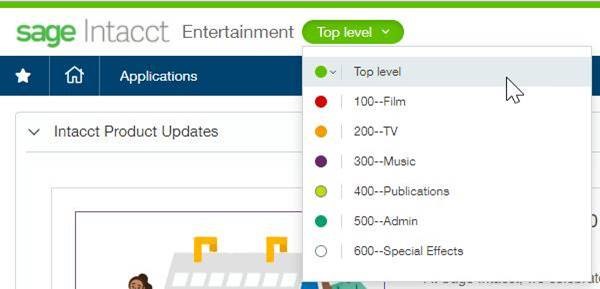Building an A-List Accounting Team
This blog post is a continuation in our series designed to help growing entertainment companies recognize and overcome some of the most common challenges in corporate accounting and finance. For related topics, click on the links below:
- Building block #2: Multi-entity accounting
Manage Your Complex Org Structure with Sage Intacct’s Multi-Entity Brilliance
Challenge
Like fire produces heat, growing entertainment companies produce a lot of legal entities. Out of necessity, each production requires one or more special-purpose entities (SPEs) created to fulfill specific or temporary objectives. The math is simple: more growth = more productions = more entities. It’s a good problem to have, but still represents a real challenge for the accounting team.
Entry-level products like QuickBooks or legacy applications such as Dynamics GP (Great Plains) weren’t truly designed to manage a large and complex entity structure. Each entity is essentially its own data silo, which means that sharing master lists, automating intercompany transactions, and creating consolidated financial and operational reports often require manual processes and / or special add-on tools.
As an example, RKL has worked with various prospective clients whose chart of accounts, vendor, and customer lists don’t match between entities and consolidated reporting is extremely difficult and time-consuming.
The inevitable and regrettable result for the accounting team is that they end up spending their valuable time on manual processes and reporting, which limits their ability to properly analyze data and business trends. In other words, they’re limited by older technology from adding as maximum strategic value to the organization.

Solution
Sage Intacct was architected for multi-entity organizations. Users are able to work at the “top level,” which provides a consolidated view and data entry capabilities for all entities (with proper security). The top level is a standard feature in the Sage Intacct multi-entity shared environment, which provides a number of important benefits to clients, including:
- View real-time, consolidated reports and dashboards
- Log in once at the “top level” and have access to any and all entities (subject to security permissions)
- Create new entities with a few clicks
- Share master lists (chart of accounts, vendors, and customers) for automated cross-entity reporting
- Centralize payables and receivables
- Automate inter-entity transactions – enter a single transaction for multiple entities from a single screen and Sage Intacct will automatically create the offsetting entries

Success Story: Legendary Entertainment converted from Sage 300 to Sage Intacct and saw tremendous time savings by using multi-entity management.
Benefits
In our client base, RKL has growing entertainment organizations with entity counts ranging from a few to close to 100! In every case, the response from our clients to Sage Intacct’s multi-entity management capabilities is overwhelmingly favorable. Top benefits include improvements in:
- Reporting and visibility – real-time consolidated reports and dashboards
- Internal controls – shared lists dramatically simplify system maintenance
- Process automation – a single login to the “top level” and automated intercompany transactions
Does a multi-entity, cloud financial management solution sound like a dream to you? When combined with Sage Intacct dimensions and account groups, the stage is set for dramatic improvements! RKL would love to tell you more and show you how transformative the Sage Intacct multi-entity shared environment can be for your business.